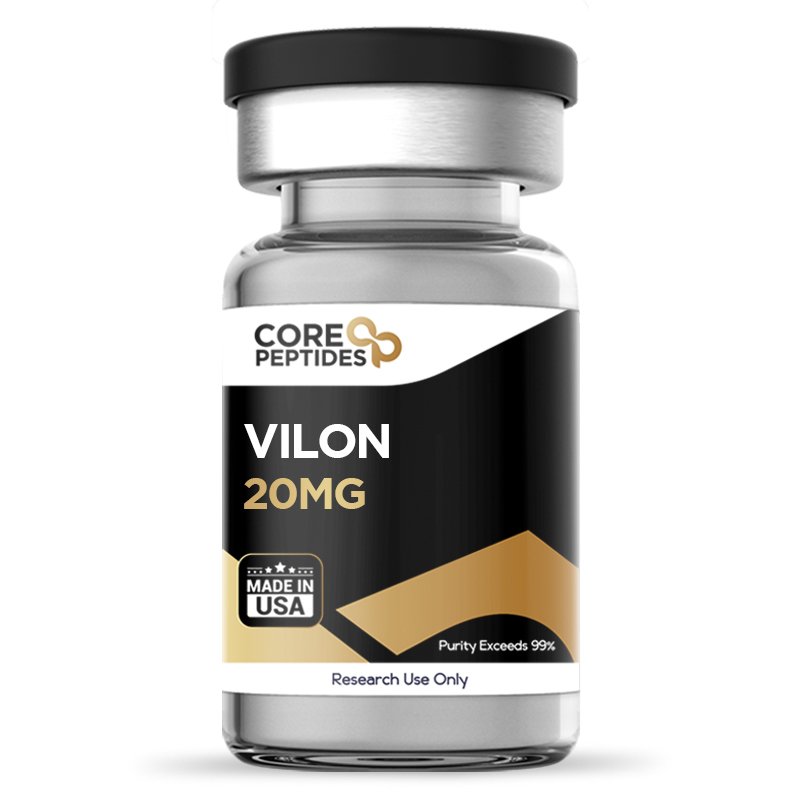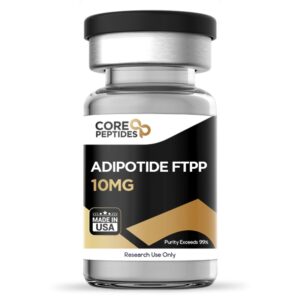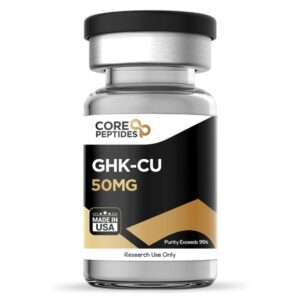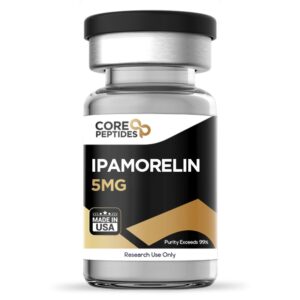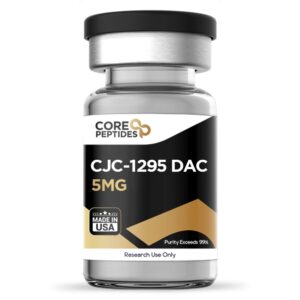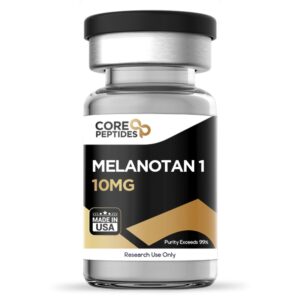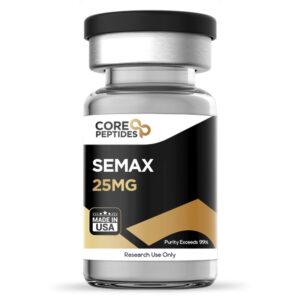Vilon (20mg)
$70.00
Size: 20mg
Contents: Vilon (20mg)
Form: Lyophilized powder
Purity: >99%
SKU: P-Vilon
FREE Shipping on $200+ orders
FREE Bacteriostatic Water (30ml) on $200+ orders
Discount per Quantity
| Quantity | Discount | Price |
|---|---|---|
| 5 - 8 | 5% | $66.50 |
| 9 + | 10% | $63.00 |
Vilon Peptide
Vilon is a dipeptide composed of amino acids lysine and glutamic acid. It also goes by the name 'Lysylglutamic Acid or Lysylglutamate.'(1) It is the shortest peptide suggested to possess potential action in the immune system, possibly mitigate cancer cell proliferation, and potentially induce anti-aging action within cells, possibly working on tissues within the liver, heart, and kidney. Vilon appears to exert its potential by possible interaction with the chromatin structure.
Vilon peptide research has also led to the postulating of several research hypotheses, including that the peptide may act to unroll chromatin structures, that it may activate ribosomal genes stimulating the synthetic process, that it may release inactive genes, and that it may not decondense the chromatin situated on each side of the centromere of the chromosome. Through its potential action on the chromatin, Vilon may possibly alter DNA structure to reactivate the genes and cells that have gone 'silent.'
Overview
Considered a bioregulator peptide, researchers speculate that Vilon may potentially support functions within the immune system, including in immunocompromised animal models. Researchers suggest Vilon may activate the interleukin-2 protein in spleen cells, which is considered critical in maintaining immune function.(3) It may stimulate the organism to fight against microbial infection and foreign bodies and prevent harmful autoimmune responses. Vilon has been suggested to activate white blood and spleen cells and potentially naturally boost the organism to protect against autoimmune elements.
A study was conducted in 2002 with three bioregulatory peptides to study their potential on interleukin-2 mRNA synthesis in spleen cells. According to this study, “The intensity of interleukin-2 mRNA synthesis in splenocytes depended on the type, concentration, and duration of [exposure] with the peptides. Vilon and Epithalon were most potent, while Cortagen produced a less pronounced effect on interleukin-2 mRNA synthesis.”(3)
Furthermore, research suggests that Vilon peptides may possibly mitigate autoimmune action by interacting with the thymus gland. The thymus gland is considered responsible for the proliferation of T-helper cells, and with the help of the Vilon peptide, this proliferation may be further enhanced. As per N N Sevostianiva et al., the Vilon peptide is “considered as a bioactive substance possessing immunomodulator and antiallergic activity.” (4) The research indicates that there is a potential for Vilon to enhance the expression of the CD5 molecule in embryonic thymic cells. Specifically, the data revealed a tentative increase of 78% in the expression levels of CD5 in rat thymic cells and a 45% increase in embryonic thymic cells compared with the baseline levels in the control group. CD5 is a marker important in the development and maturation of T-cells in the thymus, an organ considered pivotal for the generation of immune cells. The study further hypothesizes that Vilon may influence the maturation process of thymic cells, potentially steering the development of T-cell precursors more toward becoming CD4+ T-helper cells. T-helper cells are deemed critical components of the adaptive immune system, aiding in the activation and direction of other immune cells.
Chemical Makeup
Molecular formula: C11H21N3O5
Molecular weight: 257.30g/mol
Other known titles: Lysylglutamate, normophthal, Lysylglutamic acid
Vilon Research and Clinical Studies
Extended research has produced a wide variety of hypotheses speculating on the action of the Vilon peptide, some detailed below:
Vilon Peptide and Cellular Lifespan
Vilon may potentially extend the average lifespan of certain animal models under laboratory conditions through an extension and mitigation of cell death. As stated above, Vilon has been suggested to exhibit potential in enhancing the immune system, improving physical endurance and energy levels, thereby possibly increasing average lifespan of animal test models.(5) Vilon is advised to study earlier in the test model lifespan rather than later for clearest possible action. Researchers hypothesize when a bioregulator like Vilon is exposed in vivo in lab models, it may only reverse 'silent' cells, exerting no apparent action on cells killed via apoptosis.
In another experiment, researchers explored the potential of Vilon on spleen organotypic tissue cultures derived from murine models of differing ages. The findings from this investigation suggest that Vilon potentially influences the development of the explants.(6) Further research investigated research models where the peptide was introduced into the cultural medium of tissue explants derived from murine models at varying stages of development: 3 days, 3 weeks, and 2 years old. It was posited that Vilon induces morphological stability in the tissues while potentially activating both regeneration and functional activity of the cells involved. Interestingly, the results suggest that the impact of Vilon appeared to be more pronounced in explants from older murine models. This observation leads to the hypothesis that Vilon may have potential relevance in geriatric research, focusing on the mechanisms of cell aging and regeneration. The possibility that Vilon preferentially supports older tissues might be indicative of its role in modulating age-related cellular mechanisms or promoting stability in more senescent cells.(7)
Another study examined the actions of low amounts of ionizing radiation, which apparently leads to accelerated cell aging of the thymus and spleen in murine models. Vilon was tested for its potential to mitigate this accelerated cellular aging process. The researchers tentatively suggest that Vilon partially inhibited the pro-aging action induced by the radiation. This research posits that Vilon might be of interest in the field of geriatric research, potentially as an agent to manage or reduce the impacts of cell aging in critical immune organs post-radiation exposure. The study highlights Vilon’s potential role in preserving organ function in an irradiated environment, which may be crucial for developing strategies against radiation-induced degeneration in murine models.(8)
Vilon Peptide and Carcinogenic Cells
Several studies suggest that peptide exhibits the potential to prevent some spread of carcinogenic cells by preventing the formation of new tumors, and potentially inhibiting existing tumors' growth.(9) Another study examined the potential of Vilon on the development of urinary bladder carcinogenesis in murine models exposed to N-butyl-N-(4-hydroxybutyl)nitrosamine (BBNA).(10) The experiment included a control group and a Vilon-exposed group. Each group began with 50 rats, all of which received BBNA. The primary observation was that the incidence of urinary bladder cancer cells was lower in the Vilon-exposed group compared to the control group. Specifically, cancer cells developed in 56% of the Vilon-exposed murine models versus 75.5% of the controls. This data possibly indicates that Vilon may have a moderating action on cancer cell development when exposed to BBNA. Further, the study noted a reduction in both the prevalence and severity of preneoplastic and early neoplastic changes in the urinary bladder mucosa in the Vilon-exposed murine models. In terms of morphological changes, the study reported fewer hyperplastic changes and lower malignancy rates in the Vilon group. There was a noticeable delay in the malignization of epithelial tissues in the Vilon group, suggesting a potential role of Vilon in modulating the rate or extent of tumor malignancy. Additionally, the average number of tumors per animal was lower in the Vilon group (1.5 tumors per rat) compared to the control group (2.6 tumors per rat), and the tumor cells in the Vilon-exposed rats appeared to manifest with a less aggressive growth pattern. The reduction in tumor aggressiveness and prevalence might indicate that Vilon has the potential to modulate the carcinogenic actions of BBNA. The findings suggest that Vilon, potentially acting as an immunomodulator, might inhibit the early stages of carcinogenesis as well as tumor progression in experimental models.
One study contradicts this potential property of Vilon. According to this study, when used with chemotherapeutic agents derived from platinum ions, this peptide–platinum combination may be more harmful than helpful.(11) Unfortunately, since this study only considers one specific type of chemotherapeutic action, the results reported by researchers may be inconclusive.
Vilon Peptide and the Gastrointestinal Tract
Vilon peptide may act on gastrointestinal functionality by possibly enhancing the working mechanisms of certain enzymes in the gastrointestinal tract. By doing so, the peptide exhibits potential resistance towards GI-specific ailments, and may reduce leaky bowels in animal models.(12) Acting on the small intestinal muscles, Vilon peptide may ameliorate glucose accumulation and glycine absorption.(13)
Vilon Peptide and Gene Expression
Upon presenting the Vilon peptide, researchers have suggested it exhibits potential to alter the gene expression of 36 genes in the heart. When presented with Epitalon, this number was reported as 144 genes. This suggests the peptide's possible action on genetic expression in the cardiac system, possibly impacting hemodynamic actions.(14)
Vilon Peptide and Fibrinolysis
Researchers suggested in one study that Vilon exhibits the potential to stimulate fibrinolysis and increase the concentration of natural anticoagulants in the organsim, namely antithrombin III and protein C. It was also suggested to reduce insulin levels and possibly regulate the metabolism of carbohydrates.(15) This suggests a possible interplay between Vilon's actions on coagulation and glucose regulation, although the mechanisms behind this interaction are not fully elucidated in the study. Furthermore, the study posits that Vilon may have a stabilizing impact on the immune system. This is inferred from changes in various immune cell types and immunoglobulins; notably, a reduction in T-helpers, T-dependent and non-T-dependent NK cells, and a normalization in the levels of active T-lymphocytes, B-lymphocytes, and IgA. Such findings suggest that Vilon may modulate both innate and adaptive immune responses, which may be crucial for overall immune homeostasis.
Further, Vilon is suggested to increase the permeability of mesenteric microvessels in the vascular system. As per N. Gavrisheva et al., these results indicate that “the preparation produces a potent homeostatic effect in the early period of chronic renal failure.”(16)
Vilon peptide is available for research and laboratory purposes only. Please review and adhere to our Terms and Conditions before ordering.
References:
- National Center for Biotechnology Information (2022). PubChem Compound Summary for CID 7010502, Lysylglutamic acid. Retrieved November 21, 2022 from https://pubchem.ncbi.nlm.nih.gov/compound/Lysylglutamic-acid
- Lezhava T, Khavison V, Monaselidze J, Jokhadze T, Dvalishvili N, Bablishvili N, Barbakadze S. Bioregulator Vilon-induced reactivation of chromatin in cultured lymphocytes from old people. Biogerontology. 2004;5(2):73-9. https://pubmed.ncbi.nlm.nih.gov/15105581/
- Kazakova TB, Barabanova SV, Khavinson VKh, Glushikhina MS, Parkhomenko EP, Malinin VV, Korneva EA. In vitro effect of short peptides on expression of interleukin-2 gene in splenocytes. Bull Exp Biol Med. 2002 Jun;133(6):614-6. https://pubmed.ncbi.nlm.nih.gov/12447482/
- Sevostianova NN, Linkova NS, Polyakova VO, Chervyakova NA, Kostylev AV, Durnova AO, Kvetnoy IM, Abdulragimov RI, Khavinson VH. Immunomodulating effects of Vilon and its analogue in the culture of human and animal thymus cells. Bull Exp Biol Med. 2013 Feb;154(4):562-5. English, Russian. https://pubmed.ncbi.nlm.nih.gov/23486604/
- Khavinson VK, Anisimov VN, Zavarzina NY, Zabezhinskii MA, Zimina OA, Popovich IG, Shtylik AV, Malinin VV, Morozov VG. Effect of vilon on biological age and lifespan in mice. Bull Exp Biol Med. 2000 Jul;130(7):687-90. DOI: 10.1007/BF02682106. PMID: 11140587. https://pubmed.ncbi.nlm.nih.gov/11140587/
- Bykov NM, Chalisova NI. Osobennosti deĭstviia ul'tramalykh doz vilona v organotipicheskoĭ kul'ture selezenki krys raznogo vozrasta [Characteristics of effect of ultralow doses of vilon in organotypic culture of spleens from rats of various ages]. Adv Gerontol. 2002;10:85-7. Russian. PMID: 12577696.
- Kniaz'kin IV, Iuzhakov VV, Chalisova NI, Grigor'ev EI. Funktsional'naia morfologiia organotipicheskoĭ kul'tury selezenkoi krys razlichnogo vozrasta pri deĭstvii vilona [Functional morphology of organotypic culture of spleens from rats of various ages exposed to vilon]. Adv Gerontol. 2002;9:110-5. Russian. PMID: 12096432.
- Kniaz'kin IV, Poliakova VO. Deĭstvie vilona na timus i selezenku v radiatsionnoĭ modeli prezhdevremennogo stareniia [The effect of vilon on the thymus and spleen in a radiation model of premature aging]. Adv Gerontol. 2002;9:105-9. Russian. PMID: 12096431.
- Khavinson VKh, Anisimov VN. A synthetic dipeptide vilon (L-Lys-L-Glu) inhibits the growth of spontaneous tumors and increases the life span of mice. Dokl Biol Sci. 2000 May-Jun;372:261-3. PMID: 10944717. https://pubmed.ncbi.nlm.nih.gov/10944717/
- Pliss GB, Mel'nikov AS, Malinin VV, Khavinson VK. Inhibitory effect of peptide vilon on the development of induced rat urinary bladder tumors in rats. Bull Exp Biol Med. 2001 Jun;131(6):558-60. doi: 10.1023/a:1012354603132. PMID: 11586406.
- Barykina OP, Iuzhakov VV, Chalisova NI, Kvetnoĭ IM, Konovalov SS. Sochetannoe vliianie vilona i tsiklofosfana na transplanty opukholeĭ i éksplantaty limfoidnoĭ tkani mysheĭ i krys raznogo vozrasta [Combined effect of vilon and cyclophosphane on tumor transplants and lymphoid tissue explants in mice and rats of various age]. Adv Gerontol. 2003;12:128-31. Russian. PMID: 14743610. https://pubmed.ncbi.nlm.nih.gov/14743610/
- Khavinson VKh, Timofeeva NM, Malinin VV, Cordova LA, Nikitina AA. Effect of vilon and epithalon on activity of enzymes in epithelial and subepithelial layers in small intestine of old rats. Bull Exp Biol Med. 2002 Dec;134(6):562-4. https://pubmed.ncbi.nlm.nih.gov/12660839/
- Khavinson VKh, Egorova VV, Timofeeva NM, Malinin VV, Cordova LA, Gromova LV. Effect of Vilon and Epithalon on glucose and glycine absorption in various regions of small intestine in aged rats. Bull Exp Biol Med. 2002 May;133(5):494-6. https://pubmed.ncbi.nlm.nih.gov/12420071/
- Anisimov SV, Bokheler KR, Khavinson VKh, Anisimov VN. Studies of the effects of Vilon and Epithalon on gene expression in mouse heart using DNA-microarray technology. Bull Exp Biol Med. 2002 Mar;133(3):293-9. https://pubmed.ncbi.nlm.nih.gov/12360356/
- Kuznik BI, Isakova NV, Kliuchereva NN, Maleeva NV, Pinelis IS. [Effect of vilon on the immunity status and coagulation hemostasis in patients of different age with diabetes mellitus]. Adv Gerontol. 2007;20(2):106-15. Russian. PMID: 18306698. https://pubmed.ncbi.nlm.nih.gov/18306698/
- Gavrisheva NA, Malinin VV, Ses TP, Kozlov KL, Panchenko AV, Titkov AY. Effect of peptide Vilon on the content of transforming growth factor-beta and permeability of microvessels during experimental chronic renal failure. Bull Exp Biol Med. 2005 Jan;139(1):24-6. DOI: 10.1007/s10517-005-0202-9. PMID: 16142267. https://pubmed.ncbi.nlm.nih.gov/16142267/

